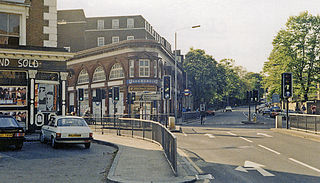
Chalk Farm is a small urban district of north west London, lying immediately north of Camden Town, in the London Borough of Camden.
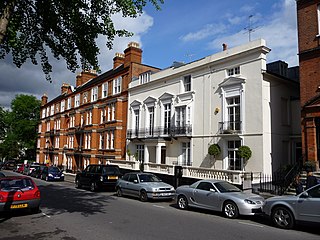
Hampstead is an area in London, England, which lies four miles northwest of Charing Cross, and extends from the A5 road to Hampstead Heath, a large, hilly expanse of parkland. The area forms the northwest part of the London Borough of Camden, a borough in Inner London which for the purposes of the London Plan is designated as part of Central London.

Hampstead was a civil parish and metropolitan borough in London, England. It was an ancient parish in the county of Middlesex, governed by an administrative vestry. The parish was included in the area of responsibility of the Metropolitan Board of Works in 1855 and became part of the County of London in 1889. The parish of Hampstead became a metropolitan borough in 1900, following the London Government Act 1899, with the parish vestry replaced by a borough council. In 1965 the borough was abolished and its former area became part of the London Borough of Camden in Greater London.

Belsize Park is a London Underground station in Belsize Park, north-west London. It is on the Edgware branch of the Northern line, between Hampstead and Chalk Farm stations, and is in Travelcard Zone 2. It stands at the northern end of Haverstock Hill. In July 2011 it became a Grade II listed building.

Gospel Oak is an inner urban area of north west London in the London Borough of Camden at the very south of Hampstead Heath. The neighbourhood is positioned between Hampstead to the north-west, Dartmouth Park to the north-east, Kentish Town to the south-east, and Belsize Park to the south-west. Gospel Oak lies across the NW5 and NW3 postcodes and is served by Gospel Oak station on the London Overground. The North London Suburb, Gospel Oak, has many schools around it.
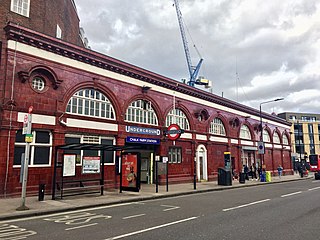
Chalk Farm is a London Underground station near Camden Town in the London Borough of Camden. It is on the Edgware branch of the Northern line between Belsize Park and Camden Town stations. For ticketing purposes, Chalk Farm falls in Travelcard Zone 2. With slightly under five million entries and exits in 2011, Chalk Farm is one of the busiest stations on the Edgware branch of the Northern line.

Belsize Park is an affluent residential area of Hampstead in the London Borough of Camden, England.

Hillfield Court is a prominent art deco residential mansion block in Belsize Park, in the London Borough of Camden, built in 1934. It is located off Belsize Avenue and can also be accessed from Glenloch Road. It is one of the many purpose built mansion blocks on Haverstock Hill between Chalk Farm and Hampstead. It is close to the amenities near Belsize Park tube station, as well as the shops of Belsize Village, South End Green and Hampstead.
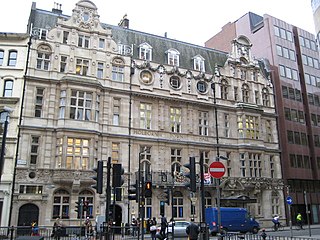
Holborn Town hall is a municipal building on High Holborn, Holborn, London. It is a Grade II listed building.

Camden Town Hall, known as St Pancras Town Hall until 1965, is the headquarters of Camden London Borough Council. The main entrance is in Judd street with its northern elevation extending along Euston Road, opposite the main front of St Pancras railway station. It has been Grade II listed since 1996.
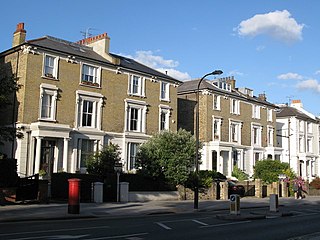
Haverstock is an area of the London Borough of Camden: specifically the east of Belsize Park, north of Chalk Farm and west of Kentish Town. It is centred on Queens Crescent and Malden Road. Gospel Oak is to the north, Camden Town to the south.
The London Borough of Camden was created in 1965 from the former area of the metropolitan boroughs of Hampstead, Holborn, and St Pancras, which had formed part of the County of London. The borough was named after Camden Town, which had gained its name from Charles Pratt, 1st Earl Camden in 1795. Since the 17th century, many famous people have lived in its various districts and neighbourhoods.

The London Borough of Camden is a London borough in Inner London, England. Camden Town Hall, on Euston Road, lies 1.4 mi (2.3 km) north of Charing Cross. The borough was established on 1 April 1965 and includes the former Central London borough of Holborn, and St Pancras and Hampstead.

The 2010 Camden Council election took place on 6 May 2010 to elect members of Camden London Borough Council in London, England. The whole council was up for election and the Labour party gained overall control of the council from no overall control.

Belsize is a ward in the London Borough of Camden, in the United Kingdom. The ward covers most of Belsize Park, between Haverstock Hill, Swiss Cottage, and Primrose Hill.

Luisa Manon Porritt is a British Liberal Democrat politician.

The Old Town Hall, Richmond on Whittaker Avenue in Richmond, London is a former municipal building which from 1893 to 1965 served as the town hall for the Municipal Borough of Richmond.

Camberwell Town Hall is a municipal building in Peckham Road, Camberwell, London, England.

Belsize Avenue is a street in the Belsize Park area of Hampstead. Located in the London Borough of Camden, it runs from Haverstock Hill westwards to a junction with Belsize Terrace and Belsize Park Gardens. It is the former carriageway approach to Belsize House, a country estate that occupied the area until it was demolished in 1853 to allow residential development. A number of houses in the street were built by William Willett around 1873.



















